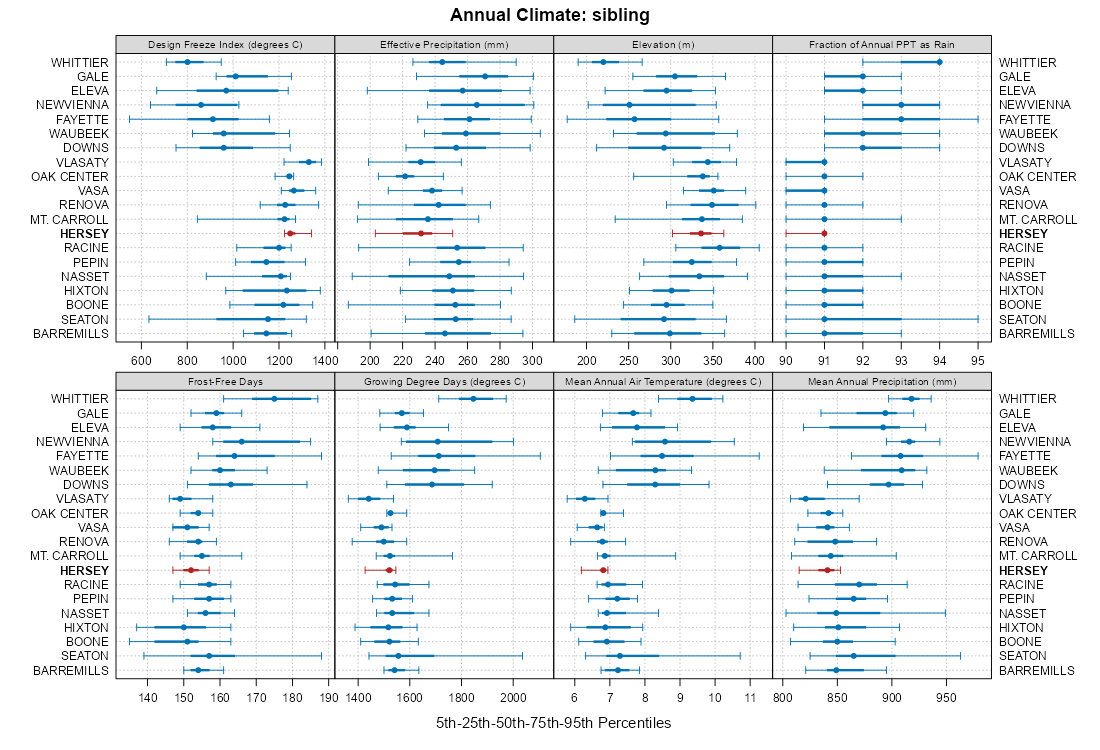| Downs-Hersey complex, 2 to 6 percent slopes | N574B | 3409 | 1386239 | 2yvb5 | mn039 | 2005 | 1:12000 |
Downs-Hersey complex, 6 to 12 percent slopes, moderately eroded | N574C2 | 3398 | 1386238 | 2yvb7 | mn039 | 2005 | 1:12000 |
Downs-Hersey, bedrock substratum, complex, 6 to 12 percent slopes, moderately eroded | N572C2 | 1545 | 1385009 | 1hh6q | mn039 | 2005 | 1:12000 |
Downs-Hersey, bedrock substratum, complex, 12 to 18 percent slopes, moderately eroded | N572D2 | 1263 | 1385010 | 1hh6r | mn039 | 2005 | 1:12000 |
Downs-Hersey, bedrock substratum, complex, 2 to 6 percent slopes | N572B | 976 | 1385002 | 1hh6h | mn039 | 2005 | 1:12000 |
Downs-Hersey complex, 12 to 18 percent slopes, moderately eroded | N574D2 | 745 | 1384991 | 2yvb9 | mn039 | 2005 | 1:12000 |
Fayette-Hersey, bedrock substratum, complex, 18 to 25 percent slopes, moderately eroded | N537E2 | 542 | 1385011 | 1hh6s | mn039 | 2005 | 1:12000 |
Fayette-Hersey complex, 18 to 25 percent slopes, moderately eroded | N560E2 | 118 | 1384999 | 1hh6d | mn039 | 2005 | 1:12000 |
Mt. Carroll-Hersey complex, 2 to 6 percent slopes | N585B | 53828 | 1591951 | 2yvbd | mn049 | 2007 | 1:12000 |
Mt. Carroll-Hersey complex, 6 to 12 percent slopes, moderately eroded | N585C2 | 30504 | 1591950 | 2yvbm | mn049 | 2007 | 1:12000 |
Downs-Hersey complex, 2 to 6 percent slopes | N574B | 10533 | 1591962 | 2yvb5 | mn049 | 2007 | 1:12000 |
Downs-Hersey complex, 6 to 12 percent slopes, moderately eroded | N574C2 | 7136 | 1591963 | 2yvb7 | mn049 | 2007 | 1:12000 |
Mt. Carroll-Hersey complex, 12 to 18 percent slopes, moderately eroded | N585D2 | 5839 | 1670133 | 2yvbn | mn049 | 2007 | 1:12000 |
Oak Center-Hersey complex, 6 to 12 percent slopes, moderately eroded | N601C2 | 1630 | 1670016 | 1t1sh | mn049 | 2007 | 1:12000 |
Downs-Hersey, bedrock substratum, complex, 12 to 18 percent slopes, moderately eroded | N572D2 | 1053 | 1711651 | 1vg3k | mn049 | 2007 | 1:12000 |
Oak Center-Hersey complex, 12 to 18 percent slopes, moderately eroded | N601D2 | 977 | 1670028 | 1t1sw | mn049 | 2007 | 1:12000 |
Downs-Hersey complex, 12 to 18 percent slopes, moderately eroded | N574D2 | 953 | 1591964 | 2yvb9 | mn049 | 2007 | 1:12000 |
Downs-Hersey, bedrock substratum, complex, 6 to 12 percent slopes, moderately eroded | N572C2 | 763 | 1711650 | 1vg3j | mn049 | 2007 | 1:12000 |
Downs-Hersey, bedrock substratum, complex, 2 to 6 percent slopes | N572B | 412 | 1711649 | 1vg3h | mn049 | 2007 | 1:12000 |
Fayette-Hersey, bedrock substratum, complex, 18 to 25 percent slopes, moderately eroded | N537E2 | 205 | 1711645 | 1vg3c | mn049 | 2007 | 1:12000 |
Mt. Carroll-Hersey complex, 6 to 12 percent slopes, moderately eroded | N585C2 | 34479 | 2216182 | 2yvbm | mn157 | 2008 | 1:12000 |
Mt. Carroll-Hersey complex, 2 to 6 percent slopes | N585B | 28458 | 721360 | 2yvbd | mn157 | 2008 | 1:12000 |
Downs-Hersey complex, 2 to 6 percent slopes | N574B | 26659 | 2025154 | 2yvb5 | mn157 | 2008 | 1:12000 |
Downs-Hersey complex, 6 to 12 percent slopes, moderately eroded | N574C2 | 26077 | 2025155 | 2yvb7 | mn157 | 2008 | 1:12000 |
Downs-Hersey complex, 12 to 18 percent slopes, moderately eroded | N574D2 | 5989 | 2216161 | 2yvb9 | mn157 | 2008 | 1:12000 |
Mt. Carroll-Hersey complex, 12 to 18 percent slopes, moderately eroded | N585D2 | 4826 | 2216184 | 2yvbn | mn157 | 2008 | 1:12000 |
Hersey-Oak Center-Mt. Carroll complex, 2 to 6 percent slopes | N520B | 4228 | 721382 | s6nd | mn157 | 2008 | 1:12000 |
Hersey-Oak Center-Mt. Carroll complex, 6 to 12 percent slopes, moderately eroded | N520C2 | 1038 | 1946887 | 23bwt | mn157 | 2008 | 1:12000 |
Downs-Hersey, bedrock substratum, complex, 6 to 12 percent slopes, moderately eroded | N572C2 | 15 | 2220168 | 2dj8b | mn157 | 2008 | 1:12000 |
Downs-Hersey, bedrock substratum, complex, 12 to 18 percent slopes, moderately eroded | N572D2 | 5 | 2220169 | 2dj8c | mn157 | 2008 | 1:12000 |
Hersey silt loam, 2 to 6 percent slopes, moderately eroded | 826B2 | 328 | 2639475 | 2yvb3 | wi011 | 1960 | 1:12000 |
Hersey silt loam, 6 to 12 percent slopes, moderately eroded | 826C2 | 6 | 2639474 | 2yvb4 | wi011 | 1960 | 1:12000 |
Hersey silt loam, 2 to 6 percent slopes, moderately eroded | 826B2 | 3232 | 2518475 | 2yvb3 | wi033 | 2003 | 1:12000 |
Hersey silt loam, 6 to 12 percent slopes, moderately eroded | 826C2 | 2872 | 2518474 | 2yvb4 | wi033 | 2003 | 1:12000 |
Hersey silt loam, 2 to 6 percent slopes, moderately eroded | 826B2 | 3025 | 2518477 | 2yvb3 | wi091 | 1998 | 1:12000 |
Hersey silt loam, 6 to 12 percent slopes, moderately eroded | 826C2 | 134 | 2518476 | 2yvb4 | wi091 | 1998 | 1:12000 |
Hersey silt loam, 2 to 6 percent slopes, moderately eroded | 826B2 | 31385 | 1693133 | 2yvb3 | wi093 | 2006 | 1:12000 |
Hersey silt loam, 6 to 12 percent slopes, moderately eroded | 826C2 | 27366 | 1693134 | 2yvb4 | wi093 | 2006 | 1:12000 |














